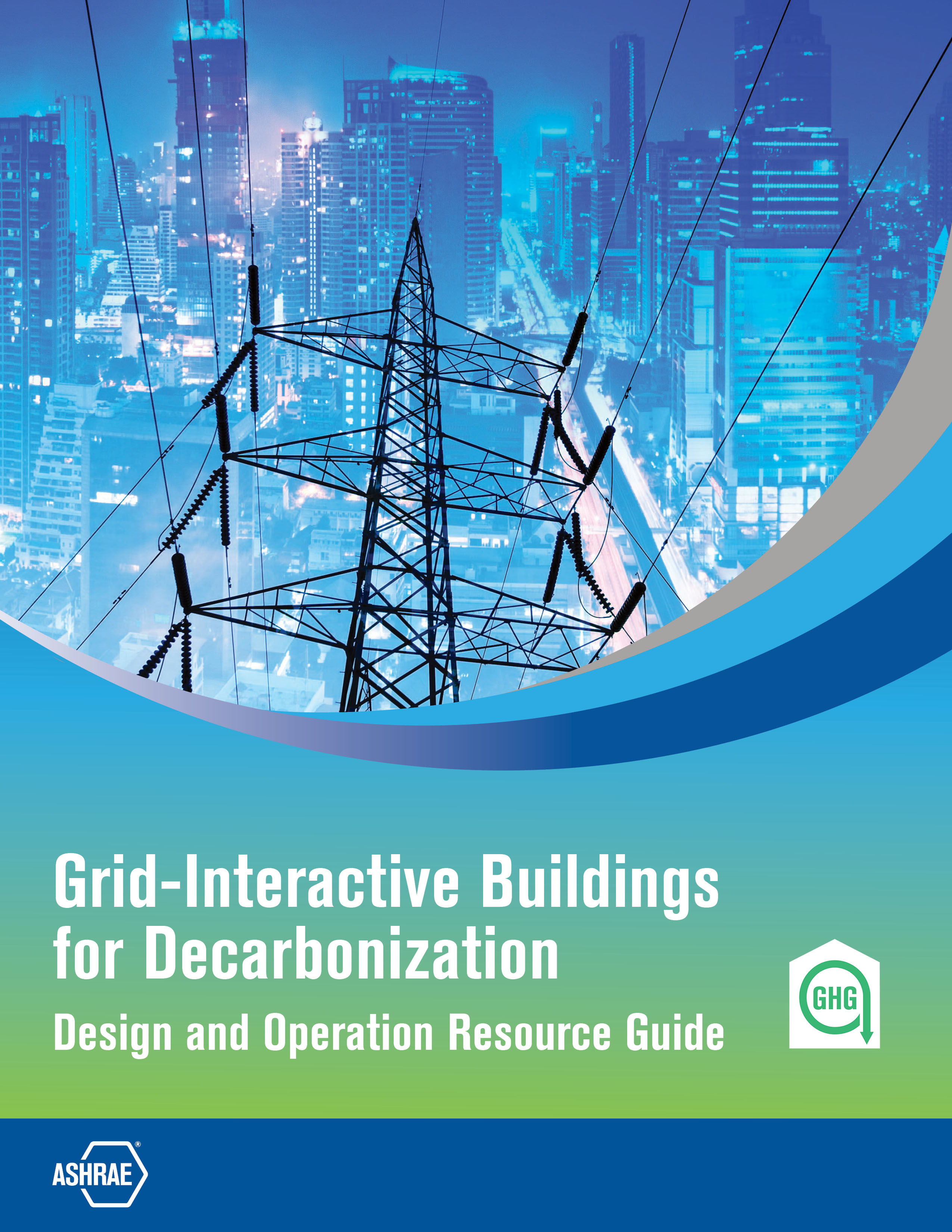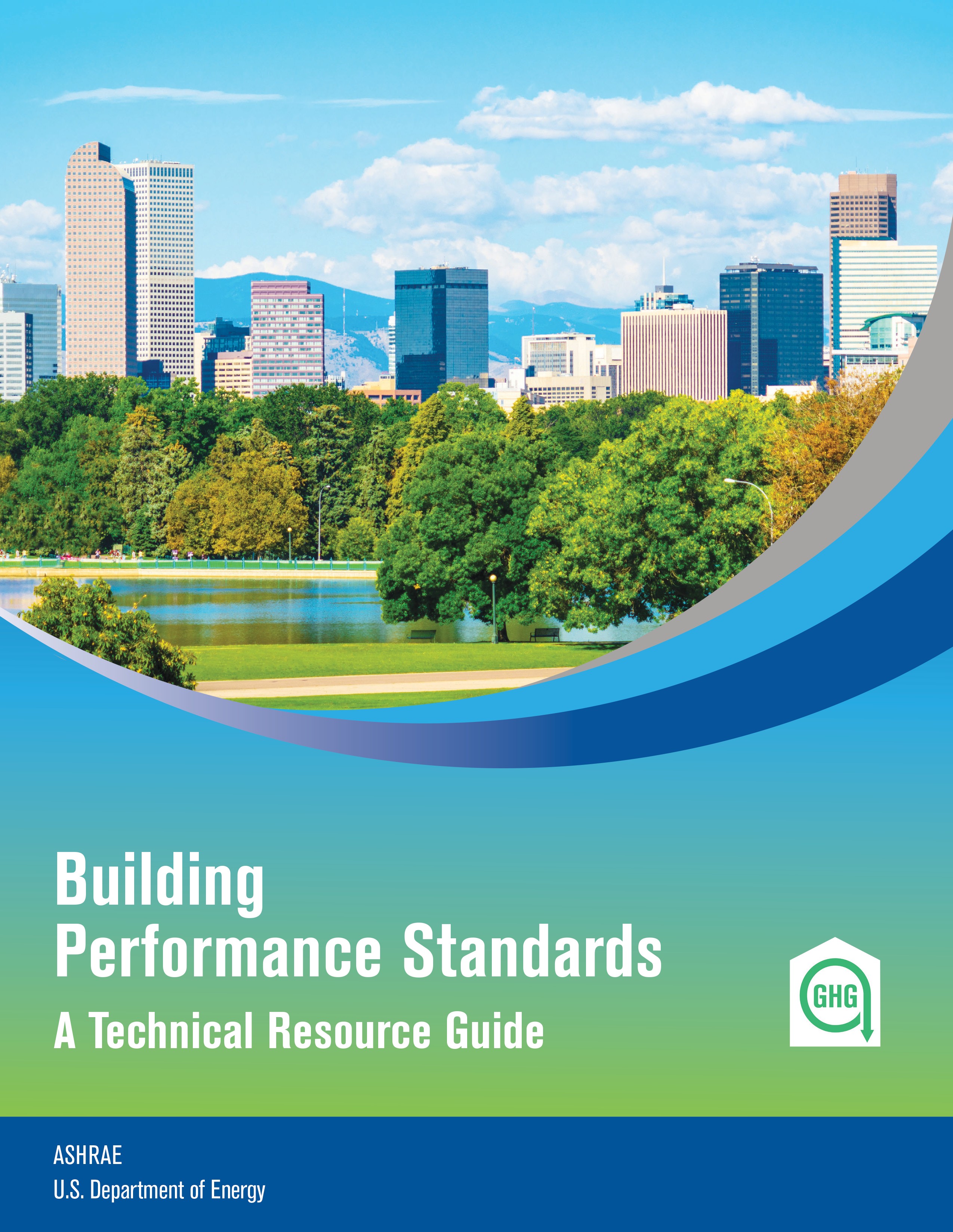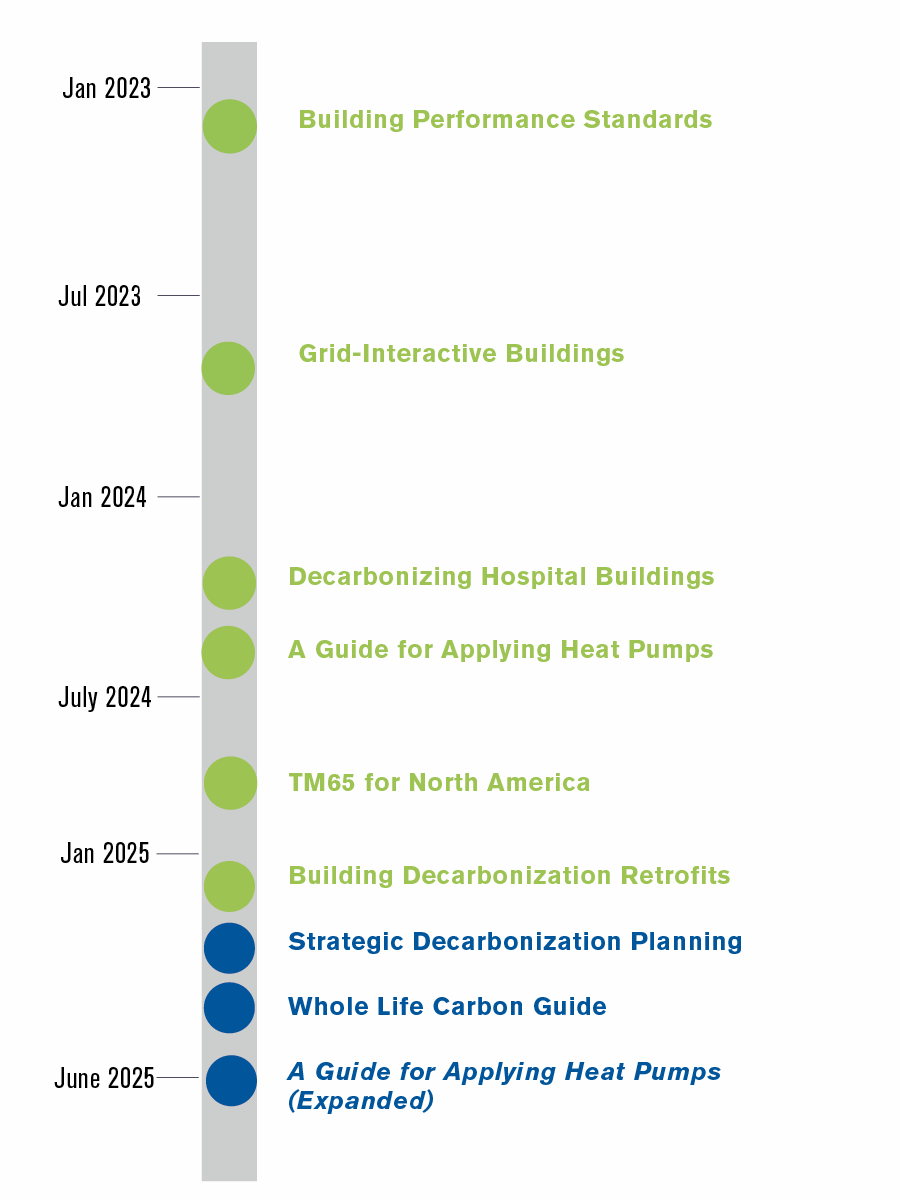-
Technical Resources: Upcoming Guides | Papers | Standards
| Related Sources | Terminology

Understanding Grid-Interactive Buildings for Decarbonization
Stay up to date with the future of sustainable building practices with the latest groundbreaking release from ASHRAE’s Task Force for Building Decarbonization (TFBD), Grid-Interactive Buildings for Decarbonization: Design and Operation Resource Guide. This is the second in a series of guides aimed at addressing the challenge of decarbonization in the built environment. Grid interactivity is a relatively new practice for most ASHRAE members, and buildings have a role in decarbonizing the power grid and managing their carbon budget; therefore, this guide provides information to enable readers to maximize carbon reduction through a building’s interaction with the electric power grid.
Purchase

Building Performance Standards: A Technical Resource Guide, The first in a series of seven guides, Building Performance Standards: A Technical Resource Guide is guide is intended to provide technical basis and resources to policymakers, building owners, facility managers, design professionals and ASHRAE members when developing and implementing a Building Performance Standard (BPS). The guide focuses on larger building types and scope of BPS as developed by leading U.S. cities and states. The guide covers BPS aimed toward reducing building operating energy use and resulting emissions and does not cover embodied energy or carbon, which are addressed by The Whole Life Carbon Guide for Building Systems.
Download now
Upcoming Guides
Five additional guides are planned for 2024.
> Learn more information

ASHRAE Decarbonization Conference Proceedings
International Building Decarbonization 2022 Conference | Athens, Greece: The conference provided a venue for information and idea exchange, between stakeholders in the built environment industry, concerning the timely and important topic of reducing carbon emissions from buildings. A primary goal of the conference was to bridge North America and Europe collaboration in decarbonization efforts. All conference papers are available here.
Standards
| ASHRAE Standard |
Energy Efficiency |
Operational Carbon Emissions |
Embodied Carbon Emissions |
Refrigerant Emissions |
Renewables |
| Standard 90.1-2022, Energy Standard for Sites and Buildings Except Low-Rise Residential Buildings |
✔️ |
☐ |
|
|
✔️ |
| Standard 90.2-2018, Energy-Efficient Design of Low-Rise Residential Buildings |
✔️ |
|
|
|
✔️ |
| Standard 90.4-2022, Energy Standard for Data Centers |
✔️ |
|
|
|
|
| Standard 100-2024, Energy and Emissions Building Performance Standard for Existing Buildings |
✔️ |
|
|
|
|
| Standard 105-2021, Standard Methods of Determining, Expressing, and Comparing Building Energy Performance and Greenhouse Gas Emissions |
✔️ |
🔵 |
|
|
✔️ |
| Standard 147-2019, Reducing the Release of Halogenated Refrigerants from Refrigerating and Air-Conditioning Equipment and Systems |
|
|
|
✔️ |
|
| Standard 189.1-2023, Standard for the Design of High-Performance Green Buildings Except Low-Rise Residential Buildings |
✔️ |
🔵 |
🔵 |
|
✔️ |
| Standard 189.3-2021: Construction, and Operation of Sustainable High-Performance Health Care Facilities |
✔️ |
🔵 |
🔵 |
🔵 |
✔️ |
| Standard 227P: Passive Building Design Standard |
✅ |
|
|
✅ |
|
| Standard 228-2023, Standard Method of Evaluating Zero Net Energy and Zero Net Carbon Building Performance |
|
✔️ |
|
✔️ |
✔️ |
| Standard 240P: Evaluating Greenhouse Gas (GHG) and Carbon Emissions in Building Design, Construction and Operation |
✅ |
✅ |
✅ |
✅ |
✅ |
| Standard 242P, Standard Method for Calculation of Building Operational Greenhouse Gas Emissions |
✅ |
✅ |
✅ |
✅ |
✅ |
|
|
|
| ✔️ included in standard |
🔵 carbon calculation methodology included in standard |
✅ included in proposed standard |
| ☐ under consideration |
☑ carbon calculation methodology included in proposed standard |
| Return to Top
Related Outside Sources
Urban Land Institute: shapes the future of the built environment for transformative impact in communities worldwide.
Read Pumping Up Sustainability: Myth-Busting Heat Pumps in Commercial Real Estate, authoured in 2024 by Urban Land Institute and members of ASHRAE Task Force for Building Decarbonization.
Building Decarbonization Coalition: unites building industry stakeholders with energy providers, environmental organizations and local governments to power our nation's homes and workspaces with clean energy.
Our World in Data: is an open-access website published and maintained by the Oxford Martin Programme on Global Development and the University of Oxford. Researchers around the world contribute their findings to present a global perspective of how the world is changing through interactive data visualizations and explainers. The link here will take you to data, charts, tables, and sources related to the energy sector.
Urban Transitions Alliance initiative: supports industrial legacy cities from across the globe to identify common challenges, share knowledge and develop solutions to successfully guide their individual sustainable solutions. These thematic briefing sheets capture key transition challenges, solution pathways and city case studies from the Alliance cities in the field of infrastructure, mobility, energy and social transitions.
Carbon Leadership Forum (CLF): is a non-partisan, non-profit coalition of architects, engineers, contractors, material suppliers, building owners and policymakers who care about the future and are taking bold steps to decarbonize the built environment, with a keen focus on eliminating embodied carbon from buildings and infrastructure. They conduct research, provide resources, inform policy, and connect members globally through the online community.
The MEP 2040 Challenge: inspired by AIA 2030 and SE 2050, the Carbon Leadership Forum launched the MEP 2040 Challenge: “All systems engineers shall advocate for and achieve net zero carbon in their projects: operational carbon by 2030 and embodied carbon by 2040.” The website linked is a hub for sharing resources and knowledge as the challenge further develops. ASHRAE recently became supporters of the MEP 2040 Challenge.
Rocky Mountain Institute (RMI): is an independent, non-partisan, nonprofit organization of experts across disciplines working to accelerate the clean energy transition and improve lives with a global reach and reputation. They conduct research and analysis, inform policy, and work with businesses, policymakers, communities and other organizations to identify and scale energy system interventions that will cut greenhouse gas emissions at least 50% by 2030.
U.S. Department Of Energy – Better Buildings: is an initiative of the U.S. Department of Energy (DOE) designed to improve the lives of the American people by driving leadership in energy innovation. Through Better Buildings, DOE partners with leaders in the public and private sectors to make the nation’s homes, commercial buildings, and industrial plants more energy-efficient by accelerating investment and sharing successful best practices.
Building Transparency: is a Washington State nonprofit with a core mission to provide the open access data and tools necessary to enable broad and swift action across the building industry in addressing embodied carbon's role in climate change. The Embodied Carbon in Construction Calculator (EC3) is free database of construction EPDs and matching building impact calculator for use in design and material procurement.
Labs2Zero Program: the International Institute for Sustainable Laboratories (I2SL) created the Labs2Zero Program to help lab owners, managers, designers, and engineers understand the steps to decarbonize the world’s high-tech research facilities.
| Return to Top
Terminology
ASHRAE Terminology: A Comprehensive Glossary of Terms for the Built Environment
ASHRAE Terminology, a free resource, is a comprehensive online glossary of more than 3700 terms and definitions related to the built environment, with a focus on heating, ventilating, air conditioning, and refrigeration (HVAC&R), as well as building envelope, electrical, lighting, water and energy use, and measurement terms.
This searchable glossary was designed for use by engineering professionals but is also useful for architects, building owners and operators, educators, public officials, and homeowners.
Key Decarbonization Terms
 For download or print |
For download or print |  Spanish translation
Spanish translation
Anthropogenic: Resulting from or produced by human activities.
Carbon dioxide (CO2): A naturally occurring gas, CO2 is also a by-product of burning fossil fuels (such as oil, gas and coal), of burning biomass, of land-use changes (LUC) and of industrial processes (e.g., cement production). It is the principal anthropogenic greenhouse gas (GHG) that affects the Earth’s radiative balance. It is the reference gas against which other GHGs are measured and therefore has a global warming potential (GWP) of 1.
Carbon dioxide equivalent (CO2e) emission: The amount of carbon dioxide (CO2) emission that would cause the same integrated radiative forcing or temperature change, over a given time horizon, as an emitted amount of a greenhouse gas (GHG) or a mixture of GHGs. There are a number of ways to compute such equivalent emissions and choose appropriate time horizons. Most typically, the CO2-equivalent emission is obtained by multiplying the emission of a GHG by its global warming potential (GWP) for a 100-year time horizon. For a mix of GHGs it is obtained by summing the CO2-equivalent emissions of each gas. CO2-equivalent emission is a common scale for comparing emissions of different GHGs but does not imply equivalence of the corresponding climate change responses. There is generally no connection between CO2-equivalent emissions and resulting CO2-equivalent concentrations.
Carbon dioxide removal: Anthropogenic activities removing CO2 from the atmosphere and durably storing it in geological, terrestrial, or ocean reservoirs, or in products.
Decarbonization: The process of removing or reducing greenhouse gases.
Direct emissions: Greenhouse gas emissions from sources owned or controlled by the reporting entity.
Electrification: The application of novel, energy-efficient electric technologies as alternatives to fossil-fueled or non-energized processes.
Embodied carbon emissions: The total greenhouse gas emissions arising from the manufacturing, transportation, installation, maintenance, and disposal of an asset (i.e., building).
Environmental product declaration (EPD): Quantifies environmental information on the life cycle of a product to enable comparisons between products fulfilling the same function.
Global warming potential (GWP): An index developed to provide a simplified means of describing the relative ability of a chemical compound to affect radiative forcing, if emitted to the atmosphere, over its lifetime in the atmosphere, and thereby to affect the global climate. Radiative forcing reflects the factors that affect the balance between the energy absorbed by the earth and the energy emitted by it in the form of longwave infrared radiation. The GWP is defined on a mass basis relative to carbon dioxide. The GWP for a compound must be calculated up to a particular integrated time horizon, for example, 20, 100, or 500 years. The time horizon most widely accepted is 100 years.
Greenhouse gas (GHG): Greenhouse gases are those gaseous constituents of the atmosphere, both natural and anthropogenic, that absorb and emit radiation at specific wavelengths within the spectrum of terrestrial radiation emitted by the Earth’s surface, the atmosphere itself and by clouds. This property causes the greenhouse effect. Water vapour (H2O), carbon dioxide (CO2), nitrous oxide (N2O), methane (CH4) and ozone (O3) are the primary GHGs in the Earth’s atmosphere. Moreover, there are a number of entirely human-made GHGs in the atmosphere, such as the halocarbons and other chlorine- and bromine-containing substances, dealt with under the Montreal Protocol. Besides CO2, N2O and CH4, the Kyoto Protocol deals with the GHGs sulphur hexafluoride (SF6), hydrofluorocarbons (HFCs) and perfluorocarbons (PFCs).
Indirect emissions: Greenhouse gas emissions that are a consequence of the activities of the reporting entity, but occur at sources owned or controlled by another entity.
Life cycle assessment (LCA): The process of evaluating a component, product, assembly, building, etc. and its development from the moment of extraction of raw materials, transportation, processing, manufacturing, use, recyclability, and disposal and assigning a value or assessment of its cumulative and ultimate social, environmental and economic costs, benefits, and impacts. This is often referred to as a cradle-to-grave or cradle-to-cradle assessment.
Net zero carbon emissions: Achieved when anthropogenic emissions of greenhouse gases to the atmosphere are balanced by anthropogenic removals over a specified period.
Operational carbon emissions: The total greenhouse gas emissions associated with the operation of an asset (i.e., building) during the use stage of the asset.
Whole life carbon emissions: The total greenhouse gas emissions, including operational carbon emissions and embodied carbon emissions over the life cycle of an asset (i.e., building).
| Return to Top